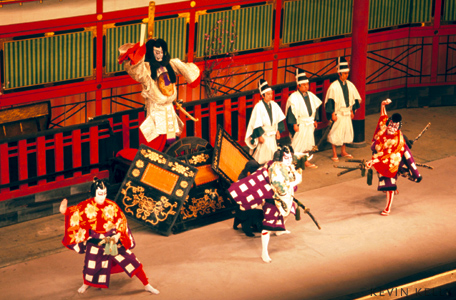Kabuki

Standing in front of the famed Kabukiza Theater in Tokyo
Ever heard of Kabuki? Maybe so.
Early in the seventeenth century, a woman named Okuni devised a new form of dramatic dance and presented it to the people of Kyoto. Called Kabuki, the dance became and remains wildly popular. Even attempts to squash it have just enhanced its fame. Known for flamboyant costumes, Kabuki became associated with prostitution. When the Japanese government banned women, the resulting all-male casts produced “onnagata”, or men playing female roles.
Still today, the scratchy, high-pitched voices of onnagata are a favorite part of Kabuki, along with its tradition of gaudy dress, brilliant sets and excessive special effects. The idea that only men participate in Kabuki is no longer a reminder of a male-dominated society but rather a fundamental portion of the Japanese aesthetic, a people with respect for obedience that aren’t afraid to look past traditional promiscuity.

This I had to see. It should be no surprise that I was determined to do it right. To me, this meant seeing a Kabuki show in the Kabuki-za Theater, which first opened its doors in 1889. A lofty, heralded building, showing a mash of modern and traditional Japanese architecture, Kabuki-za sits in a long row of tall office buildings near the enormous intersection of Showa and Harumi-dori in bustling and overcrowded Ginza (See Photo Album.
Kabuki shows can last more than three hours and reserved tickets, especially in Kabuki-za, cost well over $100 USD. As someone who loves nothing more than getting an experience at a fraction of the cost, I stood on line just before extra tickets went on sale for the final portion of a performance one cloudy Sunday afternoon.
Sure enough, for 1,000 yen ($8.50 USD) I got a seat in the last row of the fourth level for the final portion of the day’s performance. For 400 yen ($3.50 USD) I rented a radio with an English translation and prepared for one of the great Japanese experiences.
See, Kabuki has legendary stature within Japan and has affected theatre throughout the world. Costume designers and choreographers in every major style know Japan’s most famous stage performance. The idea of a revolving stage first came from the world of Kabuki, when nearly 250 years ago Namiki Shozo thought of the stage mechanism while watching a spinning top.
Perhaps what first attracts so many to Kabuki are the actors. It has been said that Western theatre is meant to be representational and thus the stories have reality-based themes. Kabuki is referred to as presentational, meant to be extraordinary and beyond the limits of life. While most Western actors are meant to give a story, Kabuki shows are meant to highlight the actor. The world “Kabuki” literally means song, dance and technique, referring to the varying abilities required of all actors.
I was given the opportunity to see Kumagai Jinya, Kumagai’s Battle Camp, one of Kabuki’s better-known productions. It portrays a clash between two samurai warriors, and as the curtains were drawn, exposing the dazzling sets for which Kabuki is known, I soon saw the production’s masculine aesthetic.
It is a story of honor: how there is no greater source than death in battle. As a chanting narrator, dressed vividly but set aside of the action, said with the entry of Genji general Kumagai, “Even a fierce warrior knows the sadness of things.”
Such is Kabuki. So much of what it once meant, and perhaps still means, to be Japanese comes through. Hidden musicians and seated choruses help heighten every step, every flutter of the oversized, overly elaborate costumes.
The shamisen music and the echoing stage of cypress all serve purposes, perfected through some three centuries of development. The white-based kumadori, facial makeup, of which there are 50 varieties today, further exemplify the exaggeration of each story’s theme. The reds that form the next level of face paint offer a striking highlight of each actor, which is as strong a player in creating a supernatural dynamic to the story.
The theater was full and the applause was robust as the curtains closed ninety minutes after I first sat down. The actors didn’t return to the stage for personal thanks – there’s certainly no individualism like that in Japan — but I left fully recognizing Kabuki’s role in promoting the actor, as the story drifts in the background as a tool.
I creaked down the steep stairway, the type that old buildings seem to always have. I walked outside and returned to the crowds of Ginza, smilingly accepting another Japanese experience accomplished.
Jaa ne,
Christopher
